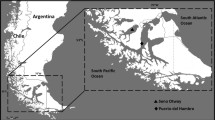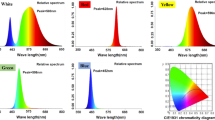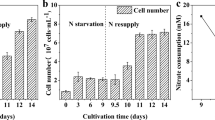Abstract
The effects of irradiance and photoperiod on the biomass and fatty acid (FA) composition of Chlorella vulgaris were examined in the exponential growth phase. Results indicated significant differences in biomass and FA at different intensities and photoperiods. Maximum biomass (2.05 ± 0.1 g l−1) was at 62.5 μmol photons m−2 s−1 and 16:8 h light/dark photoperiod. FA composition changed considerably in different light regimes; the maximum percentage of total saturated (SFA) (33.38%) was recorded at 100 μmol photons m−2 s−1 and 16:8 h photoperiod, while monounsaturated (MUFA) and polyunsaturated (PUFA) fatty acids decreased with increasing irradiance and light duration. The maximum percentage of total MUFA (15.93%) and PUFA (27.40%) was recorded at 37.5 μmol photons m−2 s−1 and 8:16 h photoperiod.


Similar content being viewed by others
References
Ackman RG (1969) Gas-liquid chromatography of fatty acids and esters. In: Lowenstein JM (ed) Methods in enzymology, vol 14. Academic Press, New York, pp 329–381
Boulus A, Spaneir E, Friedlander M (2007) Effect of outdoor conditions on growth rate and chemical composition of Gelidium crinale in culture. J Appl Phycol 19:471–478
Bouterfas R, Belkoura M, Dauta A (2006) The effects of irradiance and photoperiod on the growth rate of three freshwater green algae isolated from a eutrophic lake. Limnetica 25:647–656
Brown MR, Hohmann S (2002) Effects of irradiance and growth phase on the ascorbic acid content of Isochrysis sp. T.ISO (Prymnesiophyta). J Appl Phycol 14:211–214
Carvalho AP, Malcata FX (2005) Optimization of ω-3 fatty acid production by microalgae: crossover effect of co2 and light intensity under batch and continuous cultivation modes. Mar Biotechnol 7:1–8
Cohen Z, Norman HA, Heimer YM (1993) Potential use of substituted pyridazinones for selecting polyunsaturated fatty acid overproducing cell lines of algae. Phytochemistry 32:259–264
Danesi EDG, Rangel-Yagui CO, Carvalho JCM, Sato S (2004) Effect of reducing the light intensity on the growth and production of chlorophyll by Spirulina platensis. Biomass Bioenergy 26:29–335
Fàbregas J, Maseda A, Domínguez A, Ferreira M, Otero A (2002) Changes in the cell composition of the marine microalga, Nannochloropsis gaditana, during a light:dark cycle. Biotechnol Lett 24:1699–1703
Guillard RRL (1973) Division rates. In: Stein JR (ed) Handbook of phycological methods, vol 1. Cambridge University Press, Cambridge, pp 289–312
Harrison PJ, Thompson PA, Calderwood GS (1990) Effects of nutrient and light limitation on the biochemical composition of phytoplankton. J Appl Phycol 2:45–56
Janssen M, Kuijpers TC, Veldhoen B, Ternbach MB, Tramper J, Mur LR, Wijffels RH (1999) Specific growth rates of Chlamydomonas reinhardtii and Chlorella sorokiniana under medium duration ligh/dark cycles: 13–87 s. J Biotechnol 70:323–333
Khotimchenko SV, Yakovleva IM (2005) Lipid composition of the red alga Tichocarpus crinitus exposed to different level of photon irradiance. Phytochemistry 66:73–79
Klyachko-Gurvich G, Tsoglin LN, Doucha J, Kopetskii J, Shebalina BI, Semenenko VE (1999) Desaturation of fatty acids as an adaptive response to shifts in light intensity. Physiol Plant 07:240–249
Latasa M (1995) Pigment composition of Heterocapsa sp. and Thalassiosira weissflogii growing in batch cultures under different irradiances. Sci Mar 59:25–37
Lu C, Rao K, Hall D, Vonshak A (2001) Production of eicosapentaenoic acid (EPA) in Monodus subterraneus grown in a helical tubular photobioreactor as affected by cell density and light intensity. J Appl Phycol 13:517–522
Ma X, Chen KW, Lee YK (1997) Growth of Chlorella outdoors in a changing light environment. J Appl Phycol 9:425–430
Mansour MP, Frampton DMF, Nichols PD, Volkman JK, Blackburn SI (2005) Lipid and fatty acid yield of nine stationary phase microalgae: applications and unusual C24–C28 polyunsaturated fatty acids. J Appl Phycol 17:287–300
Patil V, Kallqvist T, Olsen E, Vogt G, Gislerød HR (2007) Fatty acid composition of 12 microalgae for possible use in aquaculture feed. Aquac Int 15:1–9
Petkov G, Garcia G (2007) Which are fatty acids of the green alga Chlorella? Biochem Syst Ecol 35:281–285
Phatarpekar PV, Sreepada RA, Pednekar C, Achuthankutty CT (2002) A comparative study on growth performance and biochemical composition of mixed culture of Isochrysis galbana and Chaetoceros calcitrans with monocultures. Aquaculture 181:141–155
Price LL, Yin K, Harrison PJ (1998) Influence of continuous light and L:D cycles on the growth and chemical composition of Prymnesiophyceae including coccolithophores. J Exp Biol Ecol 223:223–234
Renaud SM, Parry DL, Thinh LV, Kuo C, Padovan A, Sammy N (1991) Effect of light intensity on the proximate biochemical and fatty acid composition of Isochrysis sp. and Nannochloropsis oculata for use in tropical aquaculture. J Appl Phycol 3:43–53
Renaud SM, Thinh LV, Lambrinidis G, Parry DL (2002) Effect of temperature on growth, chemical composition and fatty acid composition of tropical Australian microalgae grown in batch cultures. Aquaculture 211:195–214
Richmond A (2004) Biological principles of mass cultivation. In: Richmond A (ed) Handbook of microalgal mass, culture: biotechnology and applied phycology. CRC Press, Blackwell Publishing Company, Oxford, pp 566
Sánchez-Saavedra MP, Voltolina D (2002) Effect of photon fluence rates of white and blue-green light on growth efficiency and pigment content of three diatom species in batch cultures. Cienc Mar 28(3):273–279
Sandens JM, Källqvist T, Wenner D, GislerØd HR (2005) Combined influence of light and temperature on growth rates of Nannochloropsis oceanic: linking cellural responses to large-scale biomass production. J Appl Phycol 17:515–525
Solovchenko AE, Khozin-Goldberg I, Didi-cohen S, Cohen Z, Merzlyak MN (2008) Effects of light intensity and nitrogen starvation on growth, total fatty acids and arachidonic acid in the green microalga Parietochloris incisa. J Appl Phycol 20:245–251
Thompson PA, Harrison PJ, Whyte JNC (1990) Influence of irradiance on the fatty acid composition of phytoplankton. J Phycol 26:278–288
Tzovenis I, Pauw ND, Sorgeloos P (1997) Effect of different light regimes on the docosahexaenoic acid (DHA) content of Isochrysis aff. galbana (clone T-ISO). Aquac Int 5:489–507
Ugwu CU, Aoyagi H, Uchiyama H (2007) Influence of irradiance, dissolved oxygen concentration, and temperature on the growth of Chlorella sorokiniana. Photosynthetica 45(2):309–311
Ying L, Kang-sen M, Shi-chun S, Dao-zhan Y (2001) Effect of light intensity on the total lipid and fatty acid composition of six strains of marine diatoms. Chin J Oceanol Limnol 19:249–254
Zehnder A, Gorham PR (1960) Factors influencing the growth of Microcystis aeruginosa Kutz, emend, Elenkin. Can J Microbiol 6:645–660
Zhu CJ, Lee YK, Chao TM, Lim SH (1997) Diurnal changes in gross chemical composition and fatty acid profiles of Isochrysis galbana TK1 in outdoor closed tubular photobioreactors. J Mar Biotechnol 5:153–157
Acknowledgments
The authors are grateful to the manager and staff of International Sturgeon Research Institute (Gilan Province) who kindly cooperated with us throughout the study and Tarbiat Modares University for the financial support.
Author information
Authors and Affiliations
Corresponding author
Rights and permissions
About this article
Cite this article
Amini Khoeyi, Z., Seyfabadi, J. & Ramezanpour, Z. Effect of light intensity and photoperiod on biomass and fatty acid composition of the microalgae, Chlorella vulgaris . Aquacult Int 20, 41–49 (2012). https://doi.org/10.1007/s10499-011-9440-1
Received:
Accepted:
Published:
Issue Date:
DOI: https://doi.org/10.1007/s10499-011-9440-1




